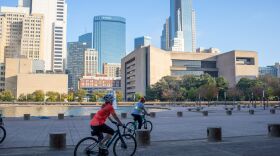The rate of traffic deaths in Dallas has been steadily increasing over the past two years. And while only 2% of Dallasites walk to work, pedestrians account for 30% of traffic deaths, according to the city.
"Public safety comes in many forms, and one of those is pedestrian safety,” Mayor Pro Tem Chad West said.
Dallas pedestrians have told city officials Dallas has a bad track record of being a city that does not value pedestrians and cyclists.
Speeding, driving under the influence, and distracted driving are some of the main reasons why severe crashes happen. The Vision Zero plan aims to eliminate traffic fatalities and achieve a 50% reduction in severe injuries by 2030.
The plan has been in the works since 2019. The city formed a task force to work on solutions, hosted town halls with residents and collaborated with city departments to make it happen.
"This is our first time as a city saying that we will no longer be car-centric and that we were going to go forward and protect pedestrians as well as cyclists [and] eventually scooter riders. And that the car-centric is not the way we're going to go in Dallas anymore,” Council Member Omar Narvaez said.

Most crashes happen on a small number of streets, according to the city. The plan reports that severe crashes usually occur at intersections and there’s a spike in the number three hours after the sun sets.
The plan went to the city council for approval after a city audit revealed last month that the city does not have any written procedures related to eliminating and reducing the risk of traffic fatalities.
The audit concluded that budget cuts to the city’s transportation department for crosswalk maintenance was part of the problem. The budget has been reduced by more than $400,000 since fiscal year 2016, according to the audit.
The Vision Zero plan promises to:
- Lower and manage speed limits
- Conduct a city-wide evaluation of speed limits (to be completed by end of 2023).
- Implement speed bumps.
- Install new pedestrian crossings.
- Develop and implement a safety education campaign.
- Expand the Dallas Police Department’s driving while intoxicated squad.
- Work with other cities to push for lower speed limits.
Got a tip? Email Alejandra Martinez at amartinez@kera.org. You can follow Alejandra on Twitter @alereports.
KERA News is made possible through the generosity of our members. If you find this reporting valuable, consider making a tax-deductible gift today. Thank you






